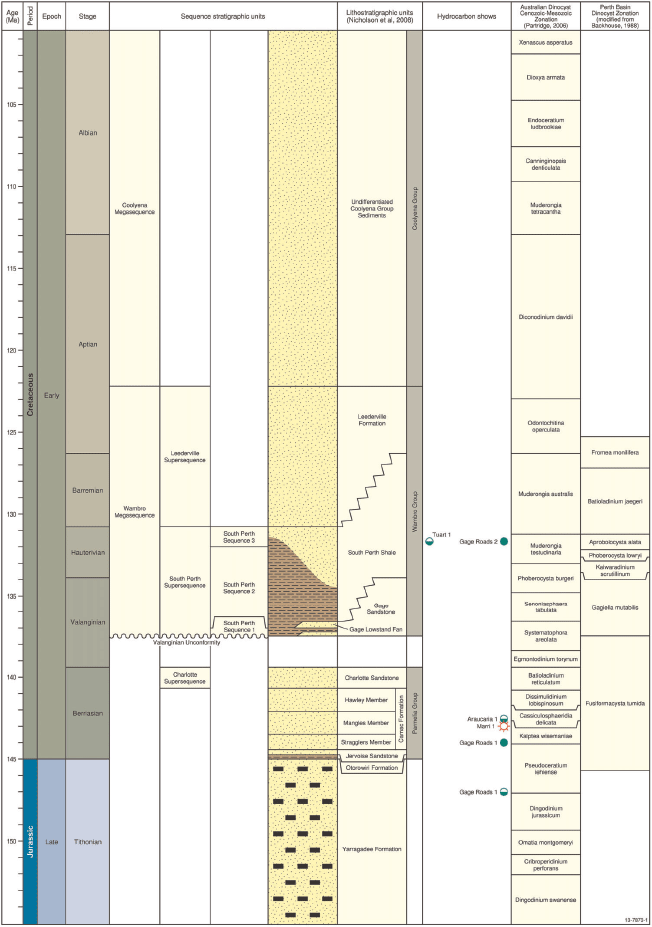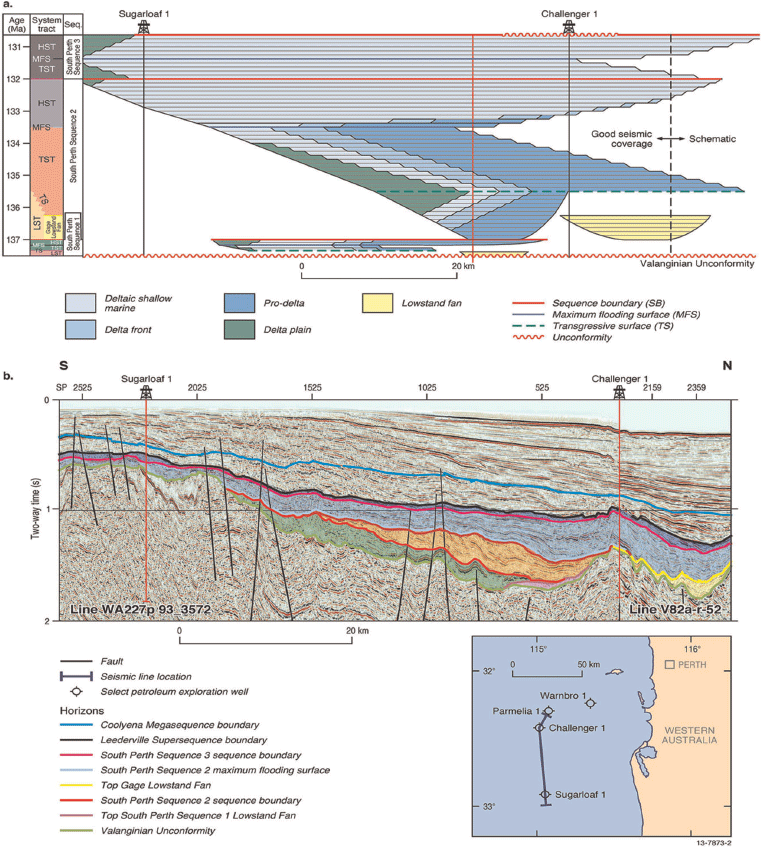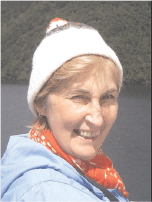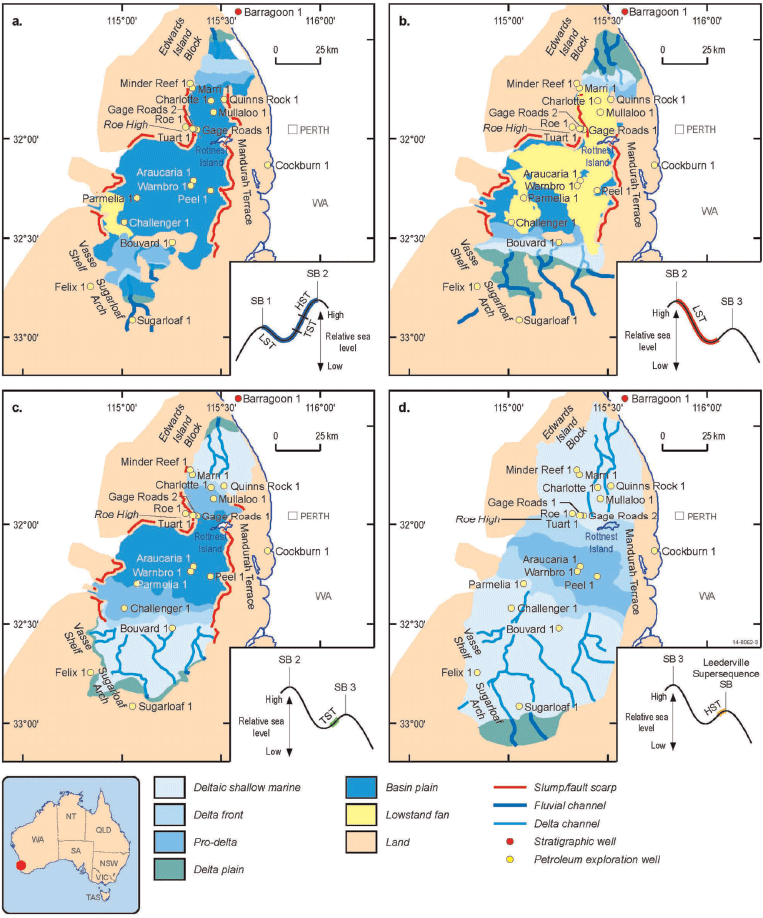Using palaeogeographic reconstructions to understand lithological variability within the Early Cretaceous Gage Sandstone and South Perth Shale in the Vlaming Sub-Basin, offshore southern Perth Basin
Megan Lech A , Chris Southby A , David Lescinsky A , Luiqi Wang A , Diane Jorgensen A , Irina Borissova A and Stephen Johnston AGeoscience Australia.
The APPEA Journal 54(2) 535-535 https://doi.org/10.1071/AJ13108
Published: 2014
Abstract
The Early Cretaceous Gage Sandstone and South Perth Shale formations are a prospective reservoir-seal pair in the Vlaming Sub-basin. Plays include post-breakup pinch-outs in the Gage Sandstone with the South Perth Shale forming top seal. The Gage reservoir has porosities of 23–30% and permeabilities of 200–1,800 mD. It was deposited in palaeotopographic lows of the Valanginian breakup unconformity and is the lowstand component of the thick deltaic South Perth (SP) Supersequence. To characterise the reservoir-seal pair, a detailed sequence stratigraphic analysis was conducted by integrating 2D seismic interpretation, well log analysis and new biostratigraphic data. Palaeogeographic reconstructions for the SP Supersequence were derived from mapping higher-order prograding packages and establishing changes in sea level and sediment supply. Higher resolution Gage reservoir reconstructions were based on seismic facies mapping. The Gage reservoir forms part of a sand-rich submarine fan system and ranges from canyon confined inner fan deposits to middle fan deposits on a basin plain. Directions of sediment supply are complex, with major sediment contributions from a northern and southern canyon adjacent to the Badaminna Fault Zone. The characteristics of the SP Supersequence differ markedly between the northern and southern parts of the sub-basin due to variations in palaeotopography and sediment supply. Palaeogeographic reconstructions reveal a series of regressions and transgressions leading to infilling of the palaeo-depression. Palaeogeographic reconstructions for the SP Supersequence portray a complex early post-rift depositional history in the central Vlaming Sub-basin. The developed approach is applicable for detailed studies of other sedimentary basins.
Introduction
As part of the Australian government’s National CO2 Infrastructure Plan, Geoscience Australia undertook a CO2 storage assessment of the Vlaming Sub-basin in the southern Perth Basin, offshore WA. The post-Valanginian breakup reservoir-seal pair investigated is also a viable target for petroleum exploration.
The Vlaming Sub-basin is an elongate, north–south trending Mesozoic depocentre that covers an area of 23,000 km2 and contains up to 14 km of sediments. The main depocentre formed during the Middle Jurassic to Early Cretaceous extension between greater India and Australia prior to their breakup in the Valanginian (Veevers, 1975; Playford et al, 1976; Veevers, 1991; Marshall et al, 1993; Harris, 1994). During this extensional phase, up to 12 km of fluvio-lacustrine sediments accumulated in the northern and central parts of the Vlaming Sub-basin. In the Valanginian, the sub-basin experienced regional uplift and erosion with a maximum uplift in the north and the south–west. Consequently, maximum deposition occurred in the central part of the sub-basin (Spring and Newell, 1993). The post-rift succession comprises up to 1,500 m of a rapidly deposited fluvio-deltaic, shelfal and submarine fan system. Deposition was controlled by the enclosed embayment geometry of the sub-basin and variations in relative sea levels (Spring and Newell, 1993; Nicholson et al, 2008).
Hydrocarbon exploration began in the offshore sub-basin in the 1960s and contains a total of 17 wells and a large volume of 2D seismic data. Sub-economic oil was discovered at Gage Roads 1 and Gage Roads 2 (West Australian Petroleum Pty Ltd, 1969, 1971), and sub-economic gas was intersected in Marri 1 (Ampolex Ltd, 1993) (Fig. 1). These accumulations together with oil shows recorded in two other wells, indicate a working petroleum system. There are no shows in the Gage reservoir (Fig. 1). Petroleum prospectivity assessments (Miyazaki et al, 1996; Crostella and Backhouse, 2000; Nicholson et al, 2008) attributed the lack of exploration success in the Vlaming Sub-basin due to poor understanding of structure, lack of seal integrity and possible accumulation breaches.

|
Spring and Newell (1993) were the first to establish a framework for the depositional systems and sequence stratigraphy of the Early Cretaceous Warnbro Group in the Vlaming Sub-basin. Their study focused on permit WA-221-P, and the prediction of reservoir and seal facies from seismic and well data. Initial screening of Australian basins by GEODISC (Bradshaw et al, 2000) identified the Vlaming Sub-basin to be prospective for CO2 storage. Subsequently, the CO2CRC (Causebrook et al, 2006) undertook an in-depth assessment of the sub-basin, evaluating the Valanginian Gage Sandstone reservoir unit and its overall storage capacity. The study demonstrated that the Gage Sandstone (Warnbro Group) is a suitable reservoir for the long-term geological storage of CO2 with the Valanginian—Hauterivian South Perth Shale (Warnbro Group) acting as a regional seal. The study also discussed possibilities for storage site locations.
The present study is a detailed sequence stratigraphic and palaeogeographic investigation of the post-Valanginian breakup reservoir-seal pair. Particular attention was paid to mapping the good quality (effective) seal and characterising the depositional environments of the Gage reservoir unit. This information was integrated into a 3D static geological model to determine reservoir heterogeneity and CO2 storage capacity.
Data and methodology
A revised understanding of the Valanginian—Hauterivian South Perth (SP) Supersequence sedimentary succession was developed using an integrated sequence stratigraphic analysis of 19 wells and >10,000 line km of 2D reflection seismic data. Sequence stratigraphic concepts, principally described by Mitchum (1977),Vail (1987), Posamentier and Vail (1988), Van Wagoner et al (1990), Posamentier and Allen (1999) and Embry (2009), were applied to the interpretation of this sedimentary succession.
New and revised biostratigraphic data (Ingram, 1991; Western Palynoservices, 1991; Monteil, 2005); Monteil et al, 2006; Macphail, (2012), wireline logs and lithological interpretations of cuttings and core samples were used to define a new chronostratigraphic sequence framework.
Palaeogeographic maps were prepared in time-slices by mapping higher-order prograding packages, and establishing changes in relative sea level and sediment supply to portray the development of the delta system. Five facies types, delta plain, deltaic shallow marine, delta front, pro-delta and submarine fan, were identified using seismo-stratigraphic techniques (Mitchum, 1977; Vail et al, 1987). The primary criteria for mapping the delta components from the seismic included identifying erosional features, such as feeder channels and canyons, shelf slope break, toe of slope break and onlap-downlap relationships. Identification of the delta’s toe of slope break allowed delineation between silty-slope sediments and pro-delta shale. These provide an effective seal for the underlying Gage submarine fan complex. The characteristics of the interpreted Gage lowstand fan were investigated further using detailed seismic faces mapping, including a numerical analysis of seismic attributes. The Gage lowstand fan was penetrated by nine wells and where possible, the seismic facies were verified by being tied to the wells.
Palaeogeographic reconstructions of South Perth Supersequence delta
The SP Supersequence is interpreted to comprise three third-order sequences, spanning 5.5 million years (see Figs 1 and 2). The palaeogeographic reconstructions shown in Fig. 3 show multiple transgressive-regressive cycles that infill the central depocentre. Variations in SP Supersequence in the north compared to the south are due to differences in palaeotopography and sediment supply. Some of the sequences are not intersected by any wells, their characteristics are derived from seismic attributes and stratal relationships with other sequences. Sequence 1 is confined to the southern and northern margins of the central sub-basin depocentre and contains submarine fan to inner shelf and highstand delta sediments (Fig. 3a). The overlying Sequence 2 contains the basal Gage lowstand fan unit, which is overlain by pro-delta shale. These grade to siltstone and sandstone as the succession transitions to highstand deltaic and shallow marine sediments (Figs 3b and 3c). The pro-delta shale seal is the thickest (around 580 m) between Gage Roads 1 and Rottnest Island, and is mostly over 200 m thick in the northern Vlaming Sub-basin and immediately south of Warnbro 1. The pro-delta shale seal is thinnest in the western and southern portions of the sub-basin. North of the study area, Sequence 3 is predominantly coarse-grained sandstone, located on the aggrading upper part of a fluvio-deltaic system (Fig. 3d). In the south, however, it is finer-grained and reflects a deeper marine setting with a more distal source to the sediment supply. By the Aptian, the sub-basin depocentre was almost completely filled.

|
The Gage reservoir forms part of a sand-rich submarine fan system, similar to the model proposed by Richards et al (1998), and was sub-divided into three units. It has core porosities of 9.5–23.9% and permeabilities from 52 to 1340 mD (West Australian Petroleum Pty Ltd, 1971; Cinar, 2013), and was deposited in broad palaeotopographic lows of the Valanginian breakup unconformity. The unit represents a lowstand component of the thick deltaic SP Supersequence. It ranges from canyon-confined inner fan deposits to middle fan deposits on an inclined and undulating basin plain, and slump deposits adjacent to the palaeotopographic highs. Directions of sediment supply are complex. Initially, major sediment contributions were from a northern and southern canyon adjacent to the Mandurah Terrace. These coalesced in the inner middle fan and extended westward onto the plain, producing the outer middle fan. As time progressed, sediment supply from the east became more significant. Although, much of the submarine fan complex is not penetrated by wells, the inner fan is interpreted to contain stacked channelised high-energy turbidites and debris flows. This part of the reservoir would provide the most suitable target for CO2 storage and hydrocarbon accumulations, as it is sandiest and has good vertical sand connectivity within the channel complex (Weimer and Slatt, 2006).
The inner middle fan is a transition zone that contains a combination of channels and suprafan lobe deposits. The sands are interpreted to have good lateral and good-moderate vertical communication and should exhibit good reservoir properties. The outer middle fan deposits are predicted to contain more fine-grained material and thin, laterally connected sand sheets. The sheet-like lobes can form good reservoirs with good lateral continuity and a narrow range in grain size (Weimer and Slatt, 2006). Like the inner and inner middle fan deposits, the outer middle fan deposits in the central Vlaming Sub-basin can also provide viable targets, although well penetration is required to confirm the reservoir’s potential. Slumps were not considered as viable targets due to their chaotic bedding, poor sand connectivity, and poorer porosity and permeability due to possible de-watering and compaction during transport and emplacement (Shipp et al, 2004).
Conclusions
Reservoir and seal facies interpretations, combined with containment constraints were used to find suitable locations for potential CO2 storage in the offshore central Vlaming Sub-basin. The analysis shows that the most lithologically prospective sites are channel sands in canyon-confined inner fan deposits where thick pro-delta shale acts as a seal. These are located between Gage Roads 1 and Rottnest Island in the northern region of the study area, and south of Warnbro 1 in the southern region of the study area. The transition zone of the inner middle fan, and sheet sands of the middle fan may also be good reservoirs and may provide suitable targets for the CO2 storage in the offshore Vlaming Sub-basin. The reservoir property interpretation derived from this study was incorporated into a 3D static geological model of the Gage reservoir to provide a more realistic and accurate representation of its CO2 storage capacity.
Palaeogeographic reconstructions for the SP Supersequence portray a more complex early post-rift depositional history in the central Vlaming Sub-basin unlike what was previously mentioned. Additional drilling and 3D seismic data could reveal the full potential for CO2 storage and petroleum accumulations in the sub-basin. This approach proved to be effective in identifying suitable storage sites and is applicable for detailed geological studies, underpinning both CO2 storage and petroleum prospectivity investigations.
Acknowledgements
The authors thank Marita Bradshaw and Steve Abbott for their constructive reviews of the draft manuscript, and Chris Evenden for drafting the figures. This work was completed as a part of the Australian Government’s National CO2 Infrastructure Plan 2011–2015. This extended abstract is published with the permission of the Chief Executive Officer from Geoscience Australia.
References
Ampolex Ltd, 1993—Well completion report Marri No. 1, unpublished.Backhouse, J., 1988—Late Jurassic and Early Cretaceous palynology of the Perth Basin, Western Australia, Geological Survey of Western Australia Bulletin 135. 233pp., unpublished.
Bradshaw, J., Bradshaw, B., Spencer, L., and Mackie, V., 2000—GEODISK Project 1 – Regional analysis. Stage 2 basins – Perth Basin, Western Australia. In: Causebrook, Dance, T., Bale, K. (eds.) 2006. CO2CRC Report Number; RP06-0162, unpublished.
Causebrook, R., Dance, T., and Bale, K., 2006—Southern Perth Basin site investigation and geological model for storage of Carbon dioxide. CO2CRC Report Number; RP06-0162, unpublished.
Cinar, Y., 2013—Geoscience Australia core analysis results. University of New South Wales, School of Petroleum Engineering Core Analysis Laboratory, unpublished.
Crostella, A., and Backhouse, J., 2000—Geology and petroleum exploration of the central and southern Perth Basin, Western Australia. Geological Survey of Western Australia Report 57. 85 pp. unpublished.
Embry, A., 2009—Practical Sequence Stratigraphy. Canadian Society of Petroleum Geologists. <www.cspg.org>.
Harris, L.B. (1994). Structural and tectonic synthesis for the Perth Basin, Western Australia Journal of Petroleum Geology 1, 129–156.
Ingram, B.S., 1991—Palynological review of wells in the Northern Vlaming Sub-basin, Perth Basin. Ampol Exploration Report 12694, DAR1164, unpublished.
Macphail, M., 2012—Palynostratigraphic analyses of samples encompassing the Valanginian unconformity in Challenger-1, Mullaloo-1, Parmelia-1, Peel-1, Quinns Rock-1 and Warnbro-1. Warnbro and Parmelia groups, Vlaming Sub-basin, Perth Basin, unpublished.
Marshall, J.F., Ramsay, D.C., Moore, A.M.G., Shafik, S., Graham, T.G., and Needham, J., 1993—The Vlaming Sub-basin, offshore South Perth Basin. AGSO, Continental Margins Folio 7. 85 pp.
Mitchum, R.M., 1977—Seismic Stratigraphy and Global Changes of Sea Level: Part I. Glossary of Terms used in Seismic Stratigraphy, in Payson, C.E. (ed.) Seismic Stratigraphy – Applications to Hydrocarbon Exploration. Association of Petroleum Geologists Memoir 26, 205–212.
Miyazaki, S., Cadman, S.J., Vuckovic, V., Davey, S.J., and Conolly, J.R. (1996). Vlaming Sub-basin Petroleum Prospectivity. Bureau of Resource Sciences, Petroleum Prospectivity Bulletin 1, 401.
Monteil, E. (2005). Biostratigraphic re-appraisal of nine wells from the northern Vlaming Sub-basin, Perth Basin, Australia. Geoscience Australia Professional Opinion 05, 14.
Monteil, E., Boreham, C., and Krassay, A., 2006—Basic Data Results from new biostratigraphic and geochemical sampling and analysis of offshore wells from the Vlaming Sub-basin, Western Australia. Geoscience Australia, Professional Opinion 2006/0. (Report for Approval to Sample No S31784), 33.
Nicholson, C.J., Borissova, I., Krassay, A.A., Boreham, C.J., Monteil, E., Neumann, V., Di Primio, R., and Bradshaw, B.E. (2008). New Exploration opportunities in the southern Vlaming Sub-basin The APPEA Journal 2008 , 371–380.
Partridge, A.D., 2006—Jurassic – Early Cretaceous spore-pollen and dinocyst zonations for Australia. In: Monteil, E. (coord.), Australian Mesozoic and Cenozoic Palynology Zonations – updated to the 2004 Geologic Time Scale. Geoscience Australia Record 2006/23.
Playford, P.E., Cockbain, A.E., and Low, G.H. (1976). The geology of the Perth Basin. Western Australia Geological Survey Bulletin 124, 311.
Posamentier, H.W., and Vail, P.R., 1988—Eustatic controls on clastic deposition II – Sequence and systems tract models. In: Wilgus, C.K., Hastings, B.S., Kendall, C.G.St.C., Posamentier, H.W., Ross, C.A., and Van Wagoner, J.C. (eds.) Sea-level changes: an integrated approach. Society of Economic Palaeontologists and Mineralogists Special Publication 42pp., 125–154.
Posamentier, H.W., and Allen, G.P., 1999—Siliciclastic sequence stratigraphy: concepts and applications, Concepts in Sedimentology and Paleontology Series 7. Society of Economic Paleontologists and Mineralogists (SEPM) 210.
Richards, M., Bowman, M., and Reading, H. (1998). Submarine-fan systems I: characterization and stratigraphic prediction Marine and Petroleum Geology 15, 689–717.
Shipp, R.C., Nott, J.A., and Newlin, J.A., 2004—Physical characteristics and impact of mass-transport complexes on deepwater jetted conductors and suction anchor piles: Offshore Technology Conference, OTC. Paper 16751, 11 pp.
Spring, D.E., and Newell, N.A. (1993). Depositional systems and sequence stratigraphy of the Cretaceous Warnbro Group, Vlaming Sub-basin, Western Australia. The APPEA Journal 3, 190–204.
Vail, P.R., 1987—Seismic stratigraphy interpretation using sequence stratigraphy, Part 1. Seismic stratigraphy interpretation procedure. In: Bally, A.W. (ed.) Atlas of seismic stratigraphy. American Association of Petroleum Geologists, Studies in Geology, 2(1), 1–10.
Van Wagoner, J.C., Mitchum, R.M., Campion, K.M., and Rahmanian, V.D. (1990). Siliciclastic sequence stratigraphy in well logs, cores and outcrops: concepts for high resolution correlation in time and space. American Association of Petroleum Geologists Methods in Exploration Series 7, 55.
Veevers, J.J., Powell, C.M., and Johnson, B.D. (1975). Greater India’s place in Gondwanaland and in Asia. Earth Planetary Science Letters 27, 383–387.
Veevers, J.J., Powell, C. Mca, and Roots, S.R. (1991). Review of seafloor spreading around Australia I. Synthesis of the patterns of spreading. Australian Journal of Earth Science 3, 373–389.
Weimer, P., and Slatt, R.M. (2006). Introduction to the petroleum geology of deepwater settings. AAPG Studies in Geology 57, 846.
West Australian Petroleum Pty Ltd, 1969—Well completion report Gage Roads No. 1, unpublished.
West Australian Petroleum Pty Ltd, 1971—Well completion report Gage Roads No. 2, unpublished.
Western Palynoservices, 1991—Perth Basin palynological review, DAR1003, unpublished.

In 2001, Megan Lech completed a BSc (honours) in geology from the Australian National University and joined Geoscience Australia as a graduate. She has conducted basin analysis studies at Mt Isa and at the offshore North Perth Basin, and she also coordinated the offshore Petroleum Acreage Release product. In 2011, Megan gained an MSc (with distinction) in petroleum geoscience from the Royal Holloway University of London. She currently works at Geoscience Australia as a basin analyst in the Vlaming Sub-basin CO2 Storage project. Megan is currently an ACT branch committee member for PESA. |

Chris Southby is a geoscientist in the Geoscience Australia Energy Division, Basin Resources Group. He completed his honours at the Australian National University in 2004 on palaeo-climate geochemistry of corals from Papua New Guinea. Since joining Geoscience Australia in 2005, he has worked on a number of projects, including the National Carbon Mapping and Infrastructure Plan. He is currently contributing to seismic interpretations and palaeogeographic mapping of the Vlaming Sub-basin to identify suitable CO2 storage locations. |

David Lescinsky completed his PhD in physical volcanology at Arizona State University in 1999. Subsequently, he was an assistant professor of earth sciences at the University of Western Ontario. In 2007, David moved to Albuquerque, New Mexico to join an environmental consultancy, developing acid gas/CO2 sequestration systems for the oil and gas sector. David joined the Geothermal Section at Geoscience Australia (GA) in March 2012 where he developed methodologies for evaluating geothermal potential using synthetic modelling. In October 2012 he began work at GA as a geological modeller on carbon capture and storage projects in the Bonaparte Basin and Vlaming Sub-basin. |

Liuqi Wang is a reservoir modeller at Geoscience Australia. He received his Bachelor and Master degree of petroleum geology, respectively in 1987 and 1990, and his PhD of petroleum engineering in 2000. His career began as an academic teacher on sedimentology and petroleum geology at the University of Petroleum, China from 1990 to 1996. He worked at Geo Visual Systems Australia PTY Ltd as a principal geologist/research scientist from 2000 to 2003. Then, he was a research fellow at the University of New South Wales. In 2008, Liuqi joined Geoscience Australia as a senior petroleum geologist/engineer. His research interest is on integrated reservoir studies for both conventional and unconventional reservoirs, including reservoir geology/geophysics, formation evaluation, modelling with geostatistics and artificial intelligence, and dynamic reservoir simulation. |

Dr Diane Jorgensen is a basin analyst in Geoscience Australia’s Basin Resources Group. She has a BA and BSc (Hons) from the University of Queensland and a PhD in carbonate sedimentology from James Cook University. At Geoscience Australia, Diane has worked in the offshore Perth and Bonaparte Basins. She is currently working within the Vlaming CO2 Storage Section, where she is focusing on well analysis, sequence stratigraphy and seismic facies mapping of the Vlaming Sub-basin. Diane is currently the treasurer of GSA ACT Division. Member: SEPM, IAS and PESA. |

Irina Borissova is a senior geoscientist in the Geoscience Australia Energy Division, Basin Resources Group. She graduated from Moscow State University and in 1985 gained a PhD from the Russian Academy of Sciences in marine geology and tectonics. Since joining Geoscience Australia in 1993, she has contributed to a number of projects, particularly to geological studies of frontier areas. Irina has been working on petroleum prospectivity assessments of the southwest margin sedimentary basins since 2004. At the moment, she is leading the CO2 storage prospectivity assessment of the Vlaming Sub-basin to identify suitable storage locations in this sub-basin. |

Stephen Johnston graduated from the University of Auckland in 2007 with a BSc in geophysics and in 2009 with an MSc in geology. He began his career at Geoscience Australia with the Basin Resources Group as a geophysicist, working on the petroleum and CO2 sequestration prospectivity of the Perth Basin. Stephen now works for DownUnder Geosolutions as a geophysicist. Member: AAPG. |



